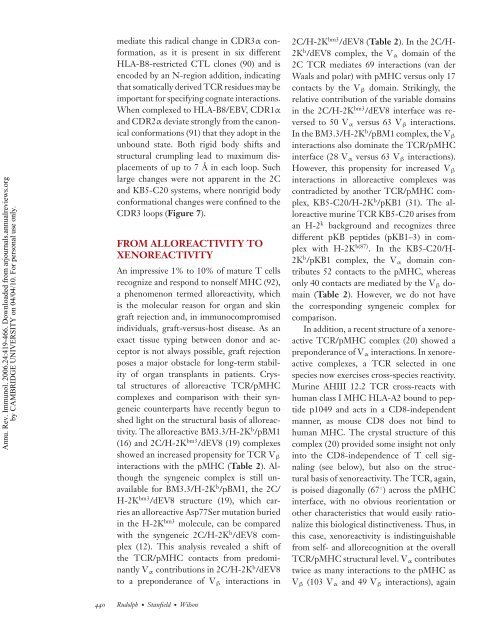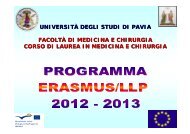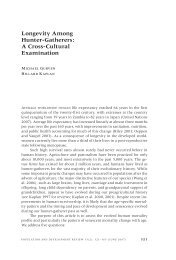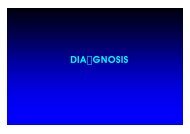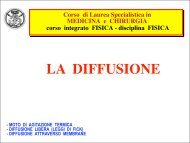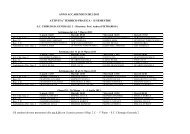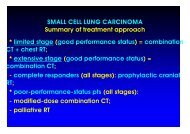Rudolph MG
Rudolph MG
Rudolph MG
Create successful ePaper yourself
Turn your PDF publications into a flip-book with our unique Google optimized e-Paper software.
Annu. Rev. Immunol. 2006.24:419-466. Downloaded from arjournals.annualreviews.org<br />
by CAMBRIDGE UNIVERSITY on 04/04/10. For personal use only.<br />
mediate this radical change in CDR3α conformation,<br />
as it is present in six different<br />
HLA-B8-restricted CTL clones (90) and is<br />
encoded by an N-region addition, indicating<br />
that somatically derived TCR residues may be<br />
important for specifying cognate interactions.<br />
When complexed to HLA-B8/EBV, CDR1α<br />
and CDR2α deviate strongly from the canonical<br />
conformations (91) that they adopt in the<br />
unbound state. Both rigid body shifts and<br />
structural crumpling lead to maximum displacements<br />
of up to 7 ˚A in each loop. Such<br />
large changes were not apparent in the 2C<br />
and KB5-C20 systems, where nonrigid body<br />
conformational changes were confined to the<br />
CDR3 loops (Figure 7).<br />
FROM ALLOREACTIVITY TO<br />
XENOREACTIVITY<br />
An impressive 1% to 10% of mature T cells<br />
recognize and respond to nonself MHC (92),<br />
a phenomenon termed alloreactivity, which<br />
is the molecular reason for organ and skin<br />
graft rejection and, in immunocompromised<br />
individuals, graft-versus-host disease. As an<br />
exact tissue typing between donor and acceptor<br />
is not always possible, graft rejection<br />
poses a major obstacle for long-term stability<br />
of organ transplants in patients. Crystal<br />
structures of alloreactive TCR/pMHC<br />
complexes and comparison with their syngeneic<br />
counterparts have recently begun to<br />
shed light on the structural basis of alloreactivity.<br />
The alloreactive BM3.3/H-2Kb /pBM1<br />
(16) and 2C/H-2Kbm3 /dEV8 (19) complexes<br />
showed an increased propensity for TCR Vβ<br />
interactions with the pMHC (Table 2). Although<br />
the syngeneic complex is still unavailable<br />
for BM3.3/H-2Kb /pBM1, the 2C/<br />
H-2Kbm3 /dEV8 structure (19), which carries<br />
an alloreactive Asp77Ser mutation buried<br />
in the H-2Kbm3 molecule, can be compared<br />
with the syngeneic 2C/H-2Kb /dEV8 complex<br />
(12). This analysis revealed a shift of<br />
the TCR/pMHC contacts from predominantly<br />
Vα contributions in 2C/H-2Kb /dEV8<br />
to a preponderance of Vβ interactions in<br />
440 <strong>Rudolph</strong>· Stanfield· Wilson<br />
2C/H-2K bm3 /dEV8 (Table 2). In the 2C/H-<br />
2K b /dEV8 complex, the Vα domain of the<br />
2C TCR mediates 69 interactions (van der<br />
Waals and polar) with pMHC versus only 17<br />
contacts by the Vβ domain. Strikingly, the<br />
relative contribution of the variable domains<br />
in the 2C/H-2K bm3 /dEV8 interface was reversed<br />
to 50 Vα versus 63 Vβ interactions.<br />
In the BM3.3/H-2K b /pBM1 complex, the Vβ<br />
interactions also dominate the TCR/pMHC<br />
interface (28 Vα versus 63 Vβ interactions).<br />
However, this propensity for increased Vβ<br />
interactions in alloreactive complexes was<br />
contradicted by another TCR/pMHC complex,<br />
KB5-C20/H-2K b /pKB1 (31). The alloreactive<br />
murine TCR KB5-C20 arises from<br />
an H-2 k background and recognizes three<br />
different pKB peptides (pKB1–3) in complex<br />
with H-2K b(87) . In the KB5-C20/H-<br />
2K b /pKB1 complex, the Vα domain contributes<br />
52 contacts to the pMHC, whereas<br />
only 40 contacts are mediated by the Vβ domain<br />
(Table 2). However, we do not have<br />
the corresponding syngeneic complex for<br />
comparison.<br />
In addition, a recent structure of a xenoreactive<br />
TCR/pMHC complex (20) showed a<br />
preponderance of Vα interactions. In xenoreactive<br />
complexes, a TCR selected in one<br />
species now exercises cross-species reactivity.<br />
Murine AHIII 12.2 TCR cross-reacts with<br />
human class I MHC HLA-A2 bound to peptide<br />
p1049 and acts in a CD8-independent<br />
manner, as mouse CD8 does not bind to<br />
human MHC. The crystal structure of this<br />
complex (20) provided some insight not only<br />
into the CD8-independence of T cell signaling<br />
(see below), but also on the structural<br />
basis of xenoreactivity. The TCR, again,<br />
is poised diagonally (67 ◦ ) across the pMHC<br />
interface, with no obvious reorientation or<br />
other characteristics that would easily rationalize<br />
this biological distinctiveness. Thus, in<br />
this case, xenoreactivity is indistinguishable<br />
from self- and allorecognition at the overall<br />
TCR/pMHC structural level. Vα contributes<br />
twice as many interactions to the pMHC as<br />
Vβ (103 Vα and 49 Vβ interactions), again


